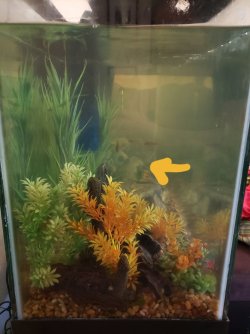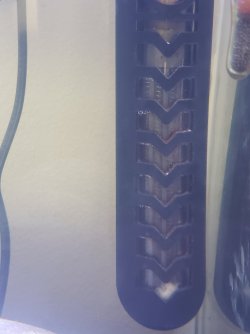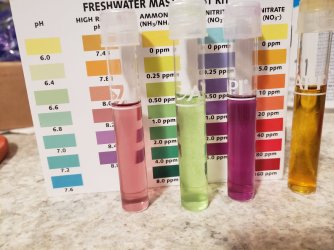I know the quickest way is to test the water, but I unfortunately do not have any tests. Mine are expired and our Walmart no longer carries any liquid tests. I ordered the API kit, but it will not be here until Friday. Hoping some of the other things going on might be abe to tell someone if it's more likely one thing than the other and what the best course of action would be until Friday.
The tank is a 55gal and has been cycled and running for almost 9yrs. It was housing 10 cherry barbs, and 1RTS. We lost the RTS late last night/early this morning after it had been swimming around normally when we went to bed. The tank also has a handful of live plants, gravel substrate, and 2 filters.
On Sunday I did a 50% water change, gravel vac (50% maybe a little less), and rinsed out one of the filters in old tank water. The fish were at the top of the tank for an hour or so, but resumed normal activity. Water was clear and everything appeared normal. On Monday morning I noticed I forgot to turn one of the filters back on. On Monday night I cleaned the other half of the gravel, changed 20-30% of the water, and rinsed the 2nd filter. The water was a bit cloudy, but I assumed that was from the leftover sand getting kicked up. Now I'm thinking I tried to clean too much all at once.
Today most of the fish are swimming okay, but they still are going up to the top of the tank occasionally (the 3 oldest ones are staying near the hob filter and not swimming much if at all). I notice if I keep moving the other filter (topfin multistage internal 40, with poor suction cups) above the waterline so it makes more movement, the fish swim around longer and act normal which made me think possibly low oxygen, but I would think that should be fixed almost 2 days later.
This morning after finding the RTS I took out 5 gallons of water and replaced with fresh, but I didn't want to do too much in fear of creating more problems (he could not have been dead more than 8hrs and I'm not sure how fast dead fish start leaching ammonia). Can I do another water change and how much would be okay? I'm assuming a water change would be okay for ammonia or oxygen problems?
The tank currently looks less cloudy and you can only notice it if you look through the side glass. Looking directly at the tank the water looks normal. I have the lights off, because I thought that would make the fish less stressed. The yellow arrow, shows about how far we could see this morning, so it seems to be clearing up and you can almost see through the whole tank again. I just do not know what would have caused the cloudiness to happen, and if a bigger water change today would help or make it worse. This morning when I just did the 5 gallons it seemed worse after than it did before.
The tank is a 55gal and has been cycled and running for almost 9yrs. It was housing 10 cherry barbs, and 1RTS. We lost the RTS late last night/early this morning after it had been swimming around normally when we went to bed. The tank also has a handful of live plants, gravel substrate, and 2 filters.
On Sunday I did a 50% water change, gravel vac (50% maybe a little less), and rinsed out one of the filters in old tank water. The fish were at the top of the tank for an hour or so, but resumed normal activity. Water was clear and everything appeared normal. On Monday morning I noticed I forgot to turn one of the filters back on. On Monday night I cleaned the other half of the gravel, changed 20-30% of the water, and rinsed the 2nd filter. The water was a bit cloudy, but I assumed that was from the leftover sand getting kicked up. Now I'm thinking I tried to clean too much all at once.
Today most of the fish are swimming okay, but they still are going up to the top of the tank occasionally (the 3 oldest ones are staying near the hob filter and not swimming much if at all). I notice if I keep moving the other filter (topfin multistage internal 40, with poor suction cups) above the waterline so it makes more movement, the fish swim around longer and act normal which made me think possibly low oxygen, but I would think that should be fixed almost 2 days later.
This morning after finding the RTS I took out 5 gallons of water and replaced with fresh, but I didn't want to do too much in fear of creating more problems (he could not have been dead more than 8hrs and I'm not sure how fast dead fish start leaching ammonia). Can I do another water change and how much would be okay? I'm assuming a water change would be okay for ammonia or oxygen problems?
The tank currently looks less cloudy and you can only notice it if you look through the side glass. Looking directly at the tank the water looks normal. I have the lights off, because I thought that would make the fish less stressed. The yellow arrow, shows about how far we could see this morning, so it seems to be clearing up and you can almost see through the whole tank again. I just do not know what would have caused the cloudiness to happen, and if a bigger water change today would help or make it worse. This morning when I just did the 5 gallons it seemed worse after than it did before.




